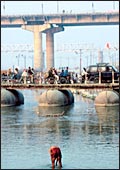|
 It's
an irony that is driven home with unfailing regularity every year.
Like at present. Even as large parts of the country-including
coastal Orissa, Andhra Pradesh, Kerala, West Bengal and, of late,
Mumbai-reel under excessive rains, there are other places (think
interior parts of Rajasthan, Andhra, Tamil Nadu, Karnataka and
Punjab) that remain bone dry. Here, growing a crop, feeding your
livestock or even quenching your thirst is an everyday challenge. It's
an irony that is driven home with unfailing regularity every year.
Like at present. Even as large parts of the country-including
coastal Orissa, Andhra Pradesh, Kerala, West Bengal and, of late,
Mumbai-reel under excessive rains, there are other places (think
interior parts of Rajasthan, Andhra, Tamil Nadu, Karnataka and
Punjab) that remain bone dry. Here, growing a crop, feeding your
livestock or even quenching your thirst is an everyday challenge.
The stark scenario is, of course, a pointer
to everything that's wrong with the country's water management.
Despite having more than 128 big and small rivers and four months
of monsoon, India is a water-scarce nation. In most cities, municipal
water supply to approved neighbourhoods is limited to a few hours
every day, while those who live in slums or poorer boroughs must
depend on private water tankers or tube wells. For farmers, water
is an even bigger issue, since their livelihoods depend on it.
The spate of farmer suicides in the drylands of Vidarbha, for
instance, is largely due to failed rains and a lack of alternative
water supply for irrigation.
| WATER FACTS |
» India's
rainfall pattern is highly seasonal, with 50 per cent precipitation
falling in just 15 days and over 90 per cent of the river
flows taking place in just four months
» India's
dams can store only 200 cubic meters per person, compared
to 5,000 in the US and 1,000 in China
» To halve
the number of people with no access to drinking water, India
will need to invest 0.55 per cent of its GDP on water schemes
between 2007 and 2017
» India
has some 20 million private tube wells and this number is
increasing by some 1 million every year
» In Punjab,
India's bread basket, the water table continues to fall every
year by half-a-metre; in Delhi, by more than half-a-metre
in certain zones |
Expect the situation to get worse. According
to a Green India study done by TERI (The Energy & Resources
Institute), the per capita availability of water in India has
declined from 6,000 cubic metres in 1947 to 2,300 cubic metres
in 1997 (the latest available figures). But TERI's Distinguished
Fellow, Ashok Jaitly, says that it's almost certain the figure
has come down further over the last nine years to around 1,800
cubic metres, simply because of population growth. Meanwhile,
in contrast, the demand for water is soaring. Merely looking at
the supply figures won't tell you the real story because, on paper,
India's total annual supply of usable water stands at 1,086 billion
cubic metres, which is enough to meet the growing demand as far
into the future as 2040. The problem, however, lies in getting
this water to consumer taps.
If the situation seems paradoxical in a country
that has more rivers than most other countries, blame it on uneven
distribution of water sources (see Water, Water Everywhere?).
India receives around 4,000 cubic kilometres of precipitation
annually, but 50 per cent of it is received in just 15 days and
more than 90 per cent of the river flows take place in just four
months. Poor storage facilities, then, make matters worse. For
instance, India can store only 200 cubic metres of water per person,
compared to 5,000 cubic metres in arid, but developed, countries
such as the United States and Australia. Says Montek Singh Ahluwalia,
Deputy Chairman, Planning Commission: "In the medium term,
water is the single-most important resource for India. One can
import oil if one runs out of oil, but you can't import water."
 Privatise
Water? Privatise
Water?
Ahluwalia says that water constraint is already
affecting the Indian economy, and farmer suicides are happening
because in the past there has not been enough investment in water
infrastructure. Just to put things in perspective, agriculture
accounts for a staggering 85 per cent of all water consumed in
the country. Industry takes out just 7 litres out of every 100,
and retail consumers even less at 4. Agriculture, unfortunately,
is also one of the most inefficient users of water. Irrigation
is still conducted through a canal system that is more than a
century old, and since most of the canals in use are unlined,
nearly 40 per cent of the water channeled into them is lost due
to seepage, points out J.S. Samra of the Indian Council for Agricultural
Research (ICAR).
INTERLINKING INDIA'S RIVERS
It's an old idea stymied by ecological
concerns and prohibitive costs. |
 |
| Troubled waters: Everyone loves
Ganga |
The idea of inter-linking India's
major rivers was first mooted by Arthur Cotton way back in
1881, and has since been advocated sporadically by others,
including engineer-statesman M. Visvesvaraya. The plan basically
involves diverting water from surplus areas to deficit ones
by harnessing rivers in the Himalayan basin and the Peninsular
basin. The plan was recently revived when the Supreme Court
in October 2002 ordered that the project be completed in the
next 12-15 years. A task force formed to examine the feasibility
of the project submitted its report in 2004. However, the
estimated cost of Rs 5,60,000 crore is not the only prohibitive
factor. The project will have an ecological impact that may
be difficult to predict, believe some scientists. The hydrological,
drainage patterns for the entire country could change. Besides,
the project must address the concerns of neighbouring countries
such as Bangladesh, Nepal and Bhutan, who fear that their
rights to the rivers flowing through their territories may
also be affected. For the moment, the UPA government has decided
to go ahead with an inter-linking plan focussed on the peninsular
rivers. But that's not to say India will have inter-linked
rivers soon. |
 |
| Supply crunch: The answer lies in rainwater
harvesting |
In cities and villages, the issues are different.
In urban areas, the existing user charges are inadequate even
to cover the operation and maintenance costs of the utilities,
never mind the sunk cost. In other words, while water in itself
may be free, consumers have to pay for the pipes that carry the
water and the treatment plants that clean it. But since water
is a politically-sensitive issue, no public utility dare raise
charges. In rural India, drinking water problem is relatively
small and more location-specific. Yet, rural schemes such as the
World Bank-funded Swajaldhara are designed to pass on a part of
the cost to the participating communities.
Normally, the answer to public sector ills
is privatisation. Profit-driven corporations are better employers
of capital than government agencies. So, is privatisation the
answer to India's water woes? It doesn't seem so. Part of the
problem stems from the fact that water, unlike cars or soaps,
is seen as a fundamental right. Therefore, non-supply of water
for non-payment of bills has health, safety and moral implications.
Countries such as France have coped well with privatisation, but
most others, including Bolivia, Argentina, and Mexico, have had
dismal experiences. Why, Atlanta, in the thick of capitalist America,
had to terminate a 20-year, $428-million water privatisation contract
after four years of experimentation, marked by losses and supply
problems. "Since private players are propelled by the profit
motive, there is a legitimate debate about the possibility and
opportunity for monopoly," says Ramesh Ramanathan of Bangalore-based
NGO, Janaagraha.
 |
| Plenty around: Veolia Water (India)'s
Mitroo is convinced that there's no shortage of water, but
only skills |
Some of the arguments against privatisation
of water are no doubt valid. But often, such contentions pre-empt
meaningful discussions over issues like water quality, maintenance
of infrastructure and rational user charges. One example is Delhi
Jal Board's (DJB) pilot project to supply pressurised water round-the-clock
in two zones in Delhi. The project, called 24x7, was grounded
last year by its opponents not because they thought it was a bad
idea, but because the World Bank and some foreign advisors were
involved in it.
Despite DJB's bad experience, efforts at privatisation
are on elsewhere in the country. France's Veolia Water is doing
a small pilot project in Chennai with some 1,500 households, and
the Karnataka government is trying out a combined project in the
three cities of Belgaon, Hubli-Dharwad and Gulbarga, with Veolia
being responsible for 10 per cent of the water supply in each
of the towns. Jamshedpur, where a Tata Group company manages water
supplies, is possibly the best example of water privatisation
in India. But then the township was always privately managed,
making it easier for the Tatas to rope in Veolia (earlier Vivendi)
as a partner. "There is no shortage of water. There is only
shortage of skills, but the government can easily hire these,"
says Promod Mitroo, Director, Veolia Water (India). Purely public
sector efforts by urban local bodies have proved inadequate because
of their financial weakness. While the National Urban Renewal
Mission is expected to help in this regard, the answer may well
be public-private partnerships like in Tirupur (see Tirupur's
Partnership Model).
TIRUPUR'S PARTNERSHIP MODEL
The small town is experimenting with a
public-private partnership model that has drawn both praise
and flak. |
 |
| Price is the key: NTADCL's Vyas
has a tough job ahead of convincing industrial units
to pay the agreed price |
Historically, Tirupur, the
hub of India's knitwear industry, relied on groundwater
and tankers to cope with its water deficit. However, partly
due to industrial pollution (chemical dyes), the groundwater
became more and more saline and contaminated. By the late
90s, the industry and Tirupur residents were sourcing water
from a growing radius of 50 km. To tackle the problem, the
Tamil Nadu Water Investment Co. (TWIC) was set up in 2001
as a joint venture between the state government and infrastructure
finance institution, IL&FS. Around the same time, the
New Tirupur Area Development Corp. Ltd (NTADCL) was formed
as a special purpose vehicle and project sponsor. Tirupur
municipality along with the Tirupur Exporters Association
pitched in, apart from the World Bank and USAID. Eighteen
wayside villages were also drawn into the project and, interestingly
enough, the villagers were willing to pay from Day One.
Today, the Rs 1,023-crore water project, which will ultimately
supply 185 million litres of potable water, has brought
some relief to the town. But there are hiccups. Some industrial
units are refusing to pay the asking price of Rs 45 per
kilolitre of water, since tankers cost only Rs 30 a kilolitre.
(Under differential pricing, retail consumers in Tirupur
pay Rs 5 and wayside villages, Rs 3.50. ) But Sameer Vyas,
NTADCL's Managing Director, is hopeful: "The project
will stabilise in another year or so." The project
won't resolve the water problem for the whole of Tirupur
and it may well continue to face resistance. But the fact
is, it has demonstrated that even relatively poor consumers
are willing to pay for water, as long as it is both safe
and reliable. It's a matter of time before industry sees
logic in it.
|
 |
| Numeric problem: TERI's Jaitly estimates
the per capita figure has come down by a fifth in less than
10 years |
Water Reforms
Water is a complex issue with many moving
parts. Any attempt at reforms, say experts, must consider everything
from the way a society treats its sources of water and the manner
in which the resource is managed (see Interlinking India's Rivers)
and then priced. Obvious gaps in the current policy include the
role of groundwater mining, then the roles of various government
agencies at the federal, state and local levels, and finally the
role of the private sector in ensuring India's water security.
But the fact that water is a state subject makes national-level
plans such as the National Water Policy 2002 more a bland statement
of intent than a blue print for water security.
Adding to the confusion is the fact that
there are no dedicated regulatory structures for water. Ultimately,
"there needs to be a good, solid policy that deals with water
through the entire ecological cycle, and not just using water
equitably between rural and urban users and then between the rich
and the poor in urban areas", says Ramanathan. The sooner
India puts such a policy in place the better. Otherwise, scenes
like the ones coming out of Mumbai and Vidarbha will continue
to mock at us and threaten our growth.
|




 I
I Privatise
Water?
Privatise
Water?



